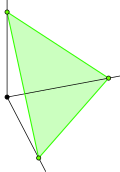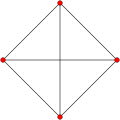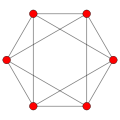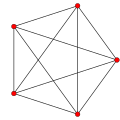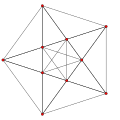Top Qs
Timeline
Chat
Perspective
Hypersimplex
From Wikipedia, the free encyclopedia
Remove ads
In polyhedral combinatorics, the hypersimplex is a convex polytope that generalizes the simplex. It is determined by two integers and , and is defined as the convex hull of the -dimensional vectors whose coefficients consist of ones and zeros. Equivalently, can be obtained by slicing the -dimensional unit hypercube with the hyperplane of equation and, for this reason, it is a -dimensional polytope when .[1]
Remove ads
Properties
The number of vertices of is .[1] The vertex-edge graph of the hypersimplex is the Johnson graph .[2]
Remove ads
Alternative constructions
An alternative construction (for ) is to take the convex hull of all -dimensional -vectors that have either or nonzero coordinates. This has the advantage of operating in a space that is the same dimension as the resulting polytope, but the disadvantage that the polytope it produces is less symmetric (although combinatorially equivalent to the result of the other construction).
The hypersimplex is also the matroid polytope for a uniform matroid with elements and rank .[3]
Remove ads
Examples
The hypersimplex is a -simplex (and therefore, it has vertices). The hypersimplex is an octahedron, and the hypersimplex is a rectified 5-cell.
Generally, the hypersimplex, , corresponds to a uniform polytope, being the -rectified -dimensional simplex, with vertices positioned at the center of all the -dimensional faces of a -dimensional simplex.
Remove ads
History
The hypersimplices were first studied and named in the computation of characteristic classes (an important topic in algebraic topology), by Gabrièlov, Gelʹfand & Losik (1975).[4][5]
References
Further reading
Wikiwand - on
Seamless Wikipedia browsing. On steroids.
Remove ads





![{\displaystyle [0,1]^{d}}](http://wikimedia.org/api/rest_v1/media/math/render/svg/e13ae4917276744b214714a20b3cb8ee305e309d)



 ...
...